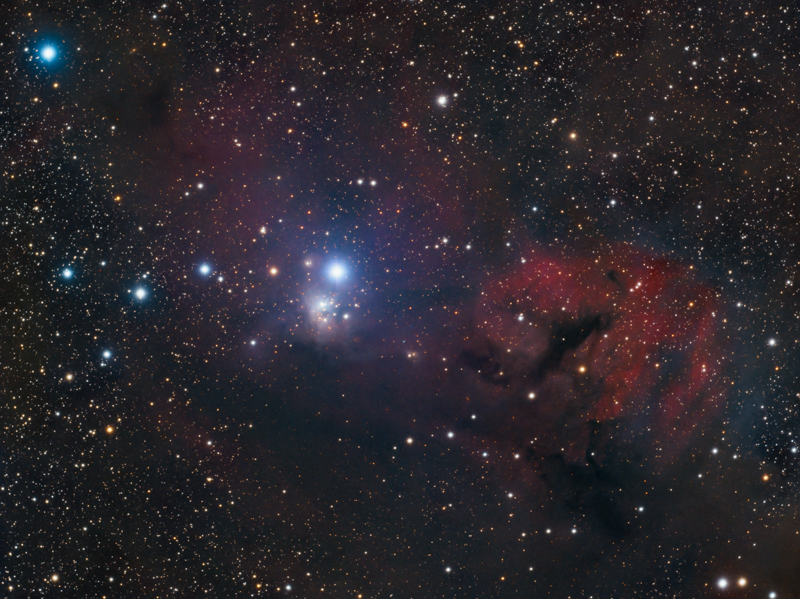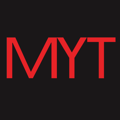
The area around star forming region IC 348 in Perseus
About this object
IC348, also known as LBN 758 is the bluish star cluster just beneath the bright star Atik near the center of this dark and dusty image. Its a star cluster shrouded by clouds of dust. The dust glows a light bluish color. The star cluster shines at magnitude 7.3 and lies roughly 1000 light years distant. It contains nearly 400 stars but in optical wavelengths with my small telescope and ccd camera only about 50 stars are visible. It was in this 2 million year old cluster that back in 2009 astronomers discovered 3 low mass brown dwarfs, smaller than jupiter:
https://www.sciencedaily.com/releases/2009/04/090422085801.htm. Using the Infared Spitzer space telescope astronomers also discovered that many of the stars in this cluster are surrounded by circumstellar disks of material. A closeup false color image from Spitzer can be seen here:
http://annesastronomynews.com/burst-of-light-discovered-in-a-suspected-binary-protostar/ic-348/. Below the star cluster is a dark cloud of dust known as Barnard 4. This dust extends off to the right into the reddish area of the image. The right side is called Barnard 3. A large reddish nebula glows behind this dust and is known as Lynds Dark Nebula (LDN) 1470. Another dark and dusty cloud is known as Barnard 5 and is located roughly between the bright star Atik near center and the bright star in the upper left. Many tiny galaxies are also in the image. An annotated image listing of these objects is linked here. This image is a blend of 15hrs of RGB and 10hrs of Ha data. The data above was reprocessed using new techniques in PixInsight. I felt the original version was a bit too harsh as there are many subtle features within the image. The previous version can be seen here: http://www.starscapeimaging.com/page215/index.html
IC348, also known as LBN 758 is the bluish star cluster just beneath the bright star Atik near the center of this dark and dusty image. Its a star cluster shrouded by clouds of dust. The dust glows a light bluish color. The star cluster shines at magnitude 7.3 and lies roughly 1000 light years distant. It contains nearly 400 stars but in optical wavelengths with my small telescope and ccd camera only about 50 stars are visible. It was in this 2 million year old cluster that back in 2009 astronomers discovered 3 low mass brown dwarfs, smaller than jupiter:
https://www.sciencedaily.com/releases/2009/04/090422085801.htm. Using the Infared Spitzer space telescope astronomers also discovered that many of the stars in this cluster are surrounded by circumstellar disks of material. A closeup false color image from Spitzer can be seen here:
http://annesastronomynews.com/burst-of-light-discovered-in-a-suspected-binary-protostar/ic-348/. Below the star cluster is a dark cloud of dust known as Barnard 4. This dust extends off to the right into the reddish area of the image. The right side is called Barnard 3. A large reddish nebula glows behind this dust and is known as Lynds Dark Nebula (LDN) 1470. Another dark and dusty cloud is known as Barnard 5 and is located roughly between the bright star Atik near center and the bright star in the upper left. Many tiny galaxies are also in the image. An annotated image listing of these objects is linked here. This image is a blend of 15hrs of RGB and 10hrs of Ha data. The data above was reprocessed using new techniques in PixInsight. I felt the original version was a bit too harsh as there are many subtle features within the image. The previous version can be seen here: http://www.starscapeimaging.com/page215/index.html
Image Details
- Optics : Stellarvue SV 70T triplet refractor
- Mount: Paramount MYT
- Camera: QSI 583
- Filters: Astrodon Type II RGB and 5nm Ha
- Exposure: HaRGB: 600:290:290:330
- Camera/Mount Control: The Sky X, CCD Auto Pilot 5
- Guiding: Unguided using ProTrack
- Processing: PixInsight 1.8,
- Location: Stark Bayou Observatory, Ocean Springs, MS
- Sky: Typical SQM 19.6-20.0, Bortle 5, Suburban
- Date: Oct-Nov 2017




